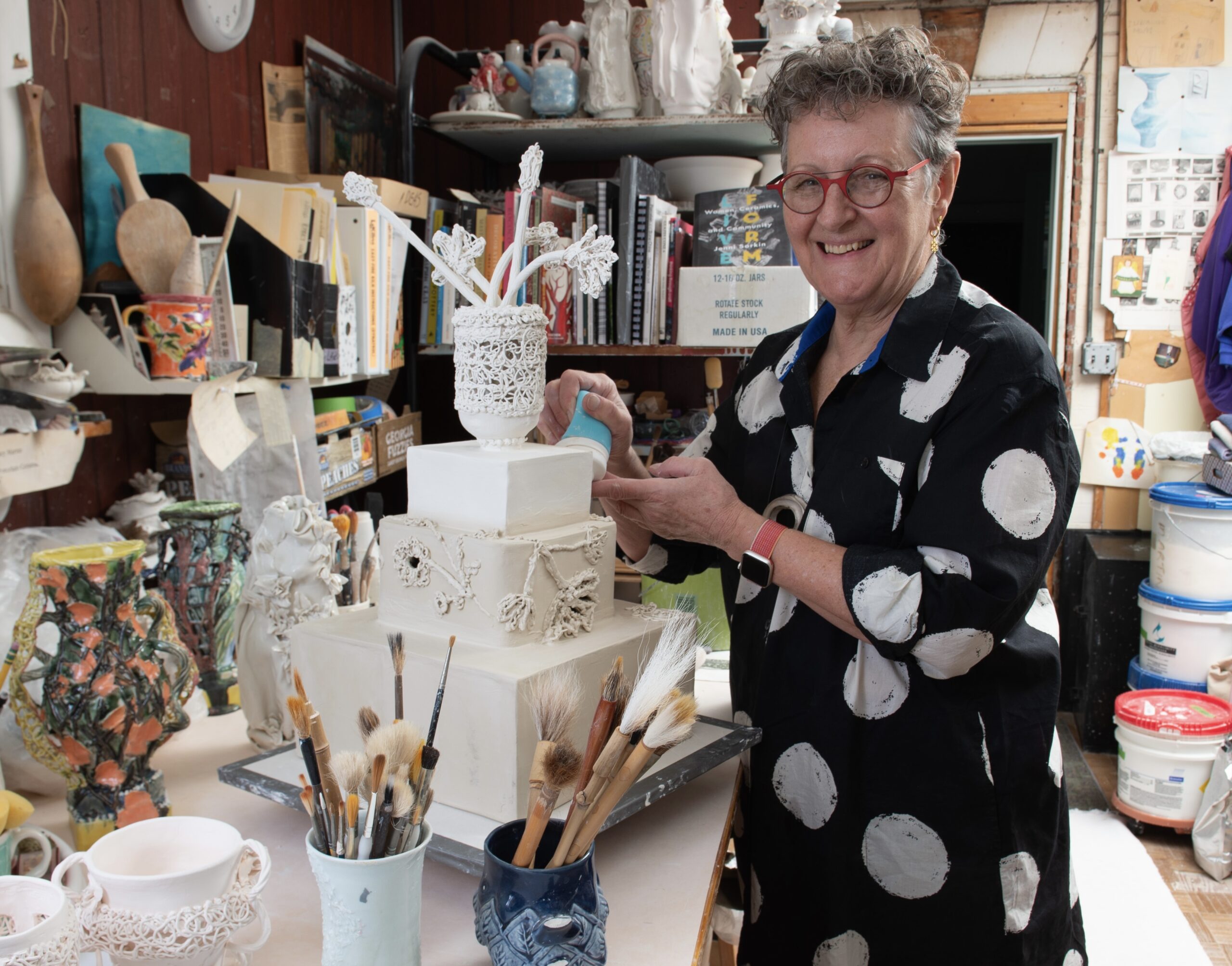
2024, 9"h x 6"w x 4"d, Media: Porcelain, Firing Process: Electric, Mid-range, Oxidation, Surface: Glazed
Artist Statement
Clay artists often get caught up in the making of objects, focusing on questions like “how will the glazes work together; are the walls of the porcelain paper clay thin enough; will the piece survive the firing?” For me, however, what matters most is the feeling connection to the piece; does it have heart, does it speak to me of mystery, does it inspire and is it beautiful? To ensure this kind of soul connection I focus on the tension between color and form aiming to imbue each piece with exuberant playfulness and to present to the viewer a conversation between art and nature.
I have deep roots in the craft traditions of England and the counterpoint between the refined and the natural. Born to an upper-class father and an artist mother (herself the daughter of a renowned stained-glass artist), I am no stranger to the tension between restrained convention and bohemian freedom. Looking back, I am not surprised that I emigrated to the United States almost forty-five years ago in search of the middle way, an artistic place where I could embody both spirits. That in turn led me, in 1985, to a BFA in Crafts from the Philadelphia College of Art.
My influences are many; among them are the beautiful gardens of my home country, the good, solid English pottery that populated my mother’s kitchen, my own mischievous clay works and the ornate Rococo era porcelains that lived in the elegant rooms of my paternal grandmother’s home. For me, art has always been a combination of heart, and head, the wild and the cultured.
I explored the interplay of these dualities in a previous body of work in which I presented the elegance of the female form, based on classical sculpture, as a carrier of nature’s exuberance by adorning them with roses, flowery forms, and textured, draped fabric-like garments. These I called The Blooming Graces.
For this new body of work I am interested in how the natural world can overwhelm and reclaim its supremacy over what is human made with all its smug superiority. My starting point was an extravagant piece of Sevres porcelain from 1757 called the Elephant Head Candelabrum Vase depicting two elephant heads whose trunks resolve marvelously and humorously into candle nozzles. Distilling and then crafting the outline of this vase, I started a dialogue between the natural and human made worlds. I introduced this outline to weeds that grow wildly, much different from archetypal English roses that are artificially hybridized and designed for color, size, and shape. Letting my natural Imagination run riot, the weeds became artistically invasive, overrunning the various iterations of the outline with a confusion of branches, tendrils, buds, and leaves on the one side, while on the other I ‘planted’ a single weed stem to stand alone, defiantly alive. These pieces are not about orderly cultivation, but more about the abundant disorder of the organic world. I then turned my attention to wild fauna in the form of snakes that squeeze and climb all over the searing manufactured blue of other Sevres inspired vases. Flora and fauna scramble the order of art to reimagine beauty from the standpoint of the goddess in all her untamed glory. Sublimated human creativity gives way to the creative natural sublime.
With my new pieces, I am presenting a much-needed compensation for our technologized world of super refined artificial reality by suggesting a new vision of beauty, whose artistic rallying cry is: let the cultivated be reimagined through the lens of nature and let its name be Rococo Revived.
Bio
Charlotte Lindley Martin, born in England in 1953, was influenced by maternal grandfather, a renowned stained glass artist, where craft was part of daily life. In 1980 she travelled to the USA with her American husband and they settled in the Philadelphia area. She graduated from Philadelphia College of Art in 1985 with a BFA in Crafts where she studied with Liz Stewart and Bill Daley. She mentored with Bill Daley and has taken workshops with Chris Staley and Nancy Blum, Mark Pharis, Alleghany Meadows and most recently Andrea and John Gill, and Liz Lerner. She considers these workshops her graduate studies. Early on in her career Charlotte began to search for a way to create functional pots with colorful decorated designs using the durability of high fire clay; these she called Hand Painted Porcelain. Charlotte continued to explore her ideas and artistic vision with Bill Daley. Exploring form and surface on her functional pots led her to the highly embellished Baroque and Rococo porcelains of the late 19th century. Bill’s advice was to make modern pots out of those baroque impulses.Mentorship continued with Jerry Bennett and the discovery of Porcelain Paper Clay. Hand building with Porcelain Paper Clay allows her to explore ideas and push forms into new realms. Flowers adorn this work, texture informs the surface, color adds emotional impact. Currently Charlotte has an exhibition at the Philadelphia International Airport as part of the PHLAirportArt program. For this work she has gone a step further into the idea of the natural world and how its beauty transforms what we see as art.










